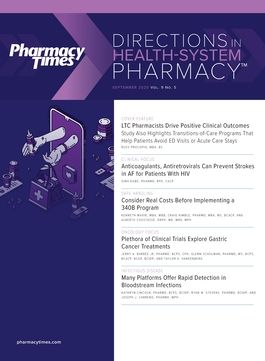Publication
Article
Pharmacy Practice in Focus: Health Systems
Using Anticoagulants to Treat Patients With Obesity Presents Challenges
Author(s):
Key Takeaways
- DOACs are divided into direct factor Xa inhibitors and direct thrombin inhibitors, with varying indications and pharmacokinetics.
- Obesity, defined by BMI, increases thrombosis risk, complicating anticoagulant therapy and necessitating careful drug selection.
Leaders in the field provide an overview of the DOAC drug class and how best to use the growing number of options.
Treating patients with obesity with anticoagulants can present difficulties that have been known and discussed for many years.
During a recent Pharmacy Times® “Practice Pearls” discussion on best practices for use of direct oral anticoagulants in obesity, leaders in the field provided an overview of drug classes in the direct oral anticoagulant (DOAC) class and discussed how to define obesity to effectively treat patients with anticoagulants.
The discussion was led by Jessica Kerr, PharmD, CDE, associate dean of Professional and Student Affairs and professor in the Department of Pharmacy Practice at Southern Illinois University Edwardsville School of Pharmacy, with participation from Paul Dobesh, PharmD, FCCP, BCPS, professor of pharmacy practice and science in the College of Pharmacy at University of Nebraska Medical Center in Omaha, and Matthew Johnson, MD, a cardiologist at Bryan Health in Lincoln, Nebraska.
The DOAC mechanism of action is broken down into direct factor Xa inhibitors and direct thrombin inhibitors, Johnson said.
The mechanism of action is pinpointed at a single molecule, as opposed to warfarin (Coumadin), which may affect multiple factors. The DOAC mechanism of action will be directed to factor Xa, except for dabigatran (Pradaxa), which is a direct thrombin inhibitor or a factor IIa inhibitor.
Kerr said the DOAC class has grown tremendously because of the research conducted over the past decade. Many of the agents have the same indications, but some have fewer or more indications than others.
The indications that these agents have tell whether they have been studied and are successful, Dobesh said, adding that 1 drug will not work for all patients—making the number of drugs available an important aspect of successful treatment.
For example, betrixaban (Bevyxxa), the newest of the DOACs, has an indication for extended prophylaxis in medically ill patients. However, it is not indicated for preventing atrial fibrillation and stroke. It is also not indicated for orthopedic surgery or venous thromboembolism (VTE), demonstrating that it has just 1 indication.
On the other hand, apixaban (Eliquis), edoxaban (Savaysa), and rivaroxaban (Xarelto) are all indicated for reducing the risk of non—valve-related defibrillation and stroke, Dobesh said. All 3 are also indicated for the treatment of VTE, both deep vein thrombosis and pulmonary embolism.
All 4 drugs have a half-life of about 12 hours. This can make dosage difficult because for 90% to 95% of the drugs used in clinical practice, the pharmacokinetics dictate the pharmacodynamics, Dobesh said.
However, for some anticoagulants, the effect of the drug is longer than the pharmacokinetic effect. For apixaban and dabigatran, each has a 12-hour half-life and provides 12 hours of anticoagulation, meaning that their pharmacodynamics and pharmacokinetics align. But edoxaban and rivaroxaban are both once-daily drugs, as their 12-hour half-life clearly provides 24 hours of anticoagulant effect. Additionally, the difference between a onceand a twice-daily drug is important to consider in terms of adherence.
In relation to defining obesity, Kerr noted that the Centers for Disease Control and Prevention and World Health Organization have published guidelines for definitions.
The best method of assessment has been body mass index (BMI), which takes the weight in kilograms over the height in meters squared, Johnson said.
In its assessment, the CDC breaks down BMI into different categories. A BMI of 25 to less than 30 falls within the overweight range. The CDC often subdivides obesity into 3 categories: Class 1 is a BMI of 30 to less than 35, class 2 is a BMI of 35 to less than 40, and class 3, “extreme” or “severe” obesity, is a BMI of 40 or higher.
A lot of simplification goes into categorizing BMI, Johnson said.
During scientific reviews of DOAC, whether post hoc analysis or randomized trials, the data often separate into those categories. The categories are generally broken down similarly, with obesity being a BMI of more than 30 and severe obesity being more than 40.
Additionally, some reviews of DOAC have been conducted to assess that 30-to-40 range, but very little data are available to review DOAC dosage and efficacy in the severe obesity range with a BMI of 40 or higher, Johnson said.
When assessing many acute and chronic disease states, it’s important to remember that patients with obesity may be at higher risk for negative outcomes associated with the specific disease state, Kerr said, noting that this is specifically the case for the risk of thrombosis in patients with obesity—as obesity is, in and of itself, a risk factor for venous thromboembolic disease. The management of thrombosis risk among patients with obesity versus other comorbidities is multifaceted.
Patients with obesity have an increased risk of developing atrial fibrillation, Dobesh said. Additionally, obesity is directly correlated to the development of diabetes from hyperinsulinemia and is directly related to hypertension.
The International Society on Thrombosis and Haemostasis (ISTH) recently released recommendations that support the use of DOACs over warfarin, except for patients with BMIs higher than 40 because of a lack of data for that population, Dobesh said.
However, noted Dobesh, despite there not being a wealth of data on the use of antibiotics in patients with BMIs higher than 40, these patients are still prescribed them.
For this reason, the decision to restrict DOAC use in these patients seems odd, Dobesh said.
The ISTH made this decision because warfarin performs better due to its ability to titrate the international normalized ratio (INR). Once an INR is achieved, the patient can be considered successfully anticoagulated. Because DOACs are not monitored, this cannot be determined.
Dobesh said that although he is aware of this recommendation from the ISTH, he no longer follows it because of evolving data over the last 4 years.
Johnson agreed with Dobesh, noting that he has also adjusted his adherence to the ISTH guidance, as new data have made clear the efficacy and safety of DOACs in patients with BMI higher than 40.
REFERENCE
Kerr J, Johnson M, Dobesh P. Best practices for the use of direct oral anticoagulants in obesity. Pharmacy Times®. July 15, 2020. Accessed July 29, 2020. https://www.pharmacytimes.com/practice-pearls/ best-practices-for-the-use-of-direct-oral-anticoagulants-in-obesity/ introduction-and-overview-of-direct-oral-anticoagulants







